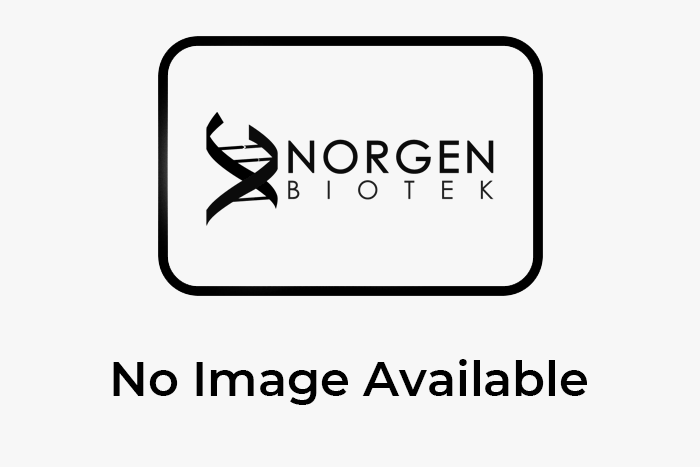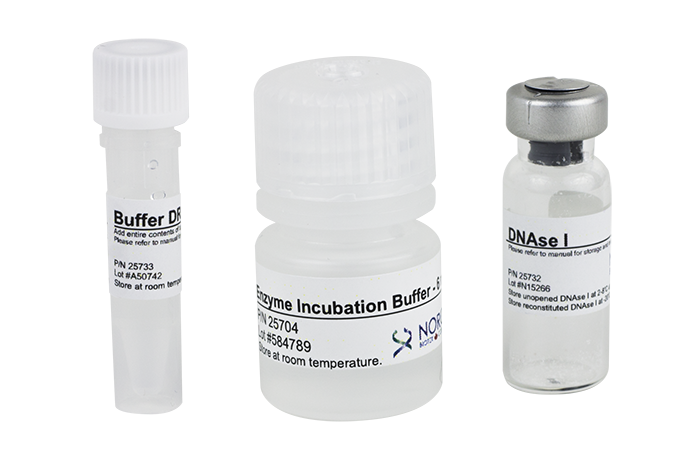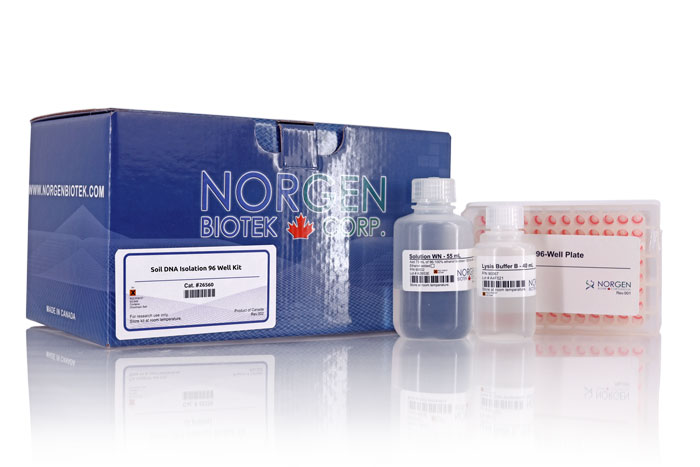Water RNA/DNA Purification Kits

For research use only and NOT intended for in vitro diagnostics.
Water RNA/DNA Purification Kits
Register today to receive an exclusive 15% off* on your first order.
Supporting Data
Figure 1. High Yield and Purity of RNA and DNA. Total RNA and DNA were simultaneously isolated from 50 mL of water sample containing 107 cfu/mL E.coli using Norgen's Water RNA/DNA Purification Kit and subsequently run on gels for visual analysis. Panel A shows 10 µL aliquots (no RNase treatment) of the 50 µL elutions run on a 1% TAE agarose gel. Genomic DNA and 16S and 23S rRNA bands were visible. Panel B shows 5 µL aliquots (on-column DNase was applied) of the elution run on a 1.5% formaldehyde agarose gel. 16S and 23S rRNA was seen without DNA contamination. From observing the gels it can be seen that the kit allows for the isolation and purification of high yields of concentrated and high quality RNA and DNA.
Figure 2. Detection of E. coli 16S rDNA by Real-Time PCR (SYBR Green) Fifty mL water samples spiked with increasing amounts of E.coli were filtrated through the provided 0.45 µm water filter columns, and RNase-treated DNA was isolated from the filter by following Norgen's Water RNA/DNA Purification Kit manual. Next, 2 µL of DNA from the 50 µL elutions was mixed in 18 µL of total real-time PCR reaction master mix and real-time PCR was performed (95°C for 3 minutes and 40 cycles at 95°C for 15 second and 60°C for 30 seconds.). All tested water samples containing different E.coli amounts were found to correspond to the real-time PCR results. E.coli was specifically detected by E. coli 16S rDNA primers down to 102 cfu/ml, indicating the quality of DNA and the efficiency of filtering system.
|
Kit Specifications
|
|
| Minimum Water Input |
10 mL
|
| Maximum Water Input |
100 mL
|
| Maximum Filter Column Loading Volume |
20 mL
|
| Maximum Spin Column Loading Volume |
650 µL
|
| Elution Volume |
100 µL
|
| Time to Complete 10 Purifications |
45 minutes
|
Storage Conditions and Product Stability
All solutions should be kept tightly sealed and stored at room temperature. This kit is stable for 2 years from the date of shipment.
| Component | Cat. 26400 (25 preps) | Cat. 26450 (25 preps) | Cat. 26480 (50 preps) |
|---|---|---|---|
| Lysis Buffer E | 15 mL | 15 mL | 2 x 15 mL |
| Wash Solution A | 18 mL | 18 mL | 38 mL |
| Enzyme Incubation Buffer B | 6 mL | 6 mL | 6 mL |
| Elution Buffer H | 6 mL | 6 mL | 6 mL |
| Mini Spin Columns | 25 | 25 | 50 |
| Filter Columns (0.22 μL) | 25 | - | - |
| Filter Columns (0.45 μL) | - | 25 | - |
| Bead Tubes | 25 | 25 | 50 |
| Collection Tubes | 25 | 25 | 50 |
| Elution Tubes (1.7 mL) | 25 | 25 | 50 |
| Product Insert | 1 | 1 | 1 |
Documentation
FAQs
Spin Column + 0.22 µm Filter, Spin Column + 0.45 µm Filter, Spin Column
Column clogging can result from one or a combination of the following factors:
- Input volume of water sample was too high.
The amount of sample input may need to be decreased to prevent clogging of the Filter Column, particularly for turbid water samples.
- Pre-filtering is necessary.
For highly turbid water samples, or samples containing high levels of sediments, pre-filtration of the sample might be necessary. Pass the sample through a 1-8 µm filter to remove debris prior to applying the sample to the Filter Column.
Lysis was not completed.
- Ensure the filter has not dried out during the 65℃ incubation step. Alternatively, increase the incubation time at 65℃ to 15 minutes.
- Ethanol was not added to the lysate.
Ensure that the appropriate amount of ethanol is added to the lysate before binding to the column.
- Ethanol was not added to the Wash Solution.
Ensure that 42 mL of 96-100% ethanol is added to the supplied Wash Solution A prior to use.
- An alternative elution buffer was used.
It is recommended that the Elution Buffer H supplied with this kit be used for maximum DNA recovery.
If the DNA or RNA does not perform well in downstream applications, it may be due to one or more of the following:
- Ethanol carryover.
Ensure that the dry spin under the Column Wash procedure is performed in order to remove traces of ethanol prior to elution. Ethanol is known to interfere with many downstream applications.
- DNA/RNA was not washed twice with the provided Wash Solutions A.
Traces of salt from the binding step may remain in the sample if the column is not washed twice with the Wash Solution A. Salt may interfere with downstream applications and thus must be washed from the column.
- PCR reaction conditions need to be optimized.
Take steps to optimize the PCR conditions being used, including varying the amount of template, changing the source of Taq polymerase, looking into the primer design, and adjusting the annealing conditions.


